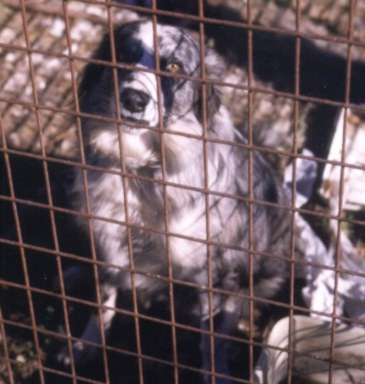 |
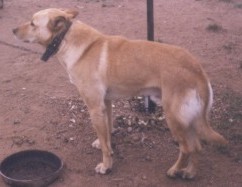 |
Koolie |
golden Kelpie |
in a mud puddle, in a litter of 9 puppies – 7 were males. |
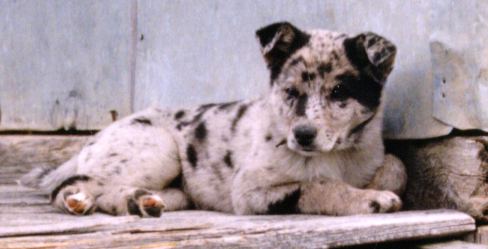 |
 |
 |
Koolie |
golden Kelpie |
in a mud puddle, in a litter of 9 puppies – 7 were males. |
 |
Selecting my Koolie
I had not owned a puppy or dog since I was a young child,
and wasn’t even sure how to distinguish the sexes. They all
looked the same – but that was mainly because they were -
there were only 2 females.
‘Silver’ the Koolie mother had made a whelping hole in the dirt next to her kennel. In fine weather it would have been a protected dirt nest. However, a cold rain was falling. The dirt nest had become a muddy puddle filled with slippery, squirming puppies. I looked at the puppies. Coral, our neighbor and the owner of ‘Silver’, said we could put them in the shed. We picked up the puppies in the drizzling rain. It was the kind of rain that drips off the brim of one’s hat and drips from exposed wisps of one’s hair– in no time one is soaked without realizing it. (The Snowy Mountains folks call that kind of rainfall: “scudding”.)
Coral, took two puppies, one in each hand, my husband Michael took two puppies, and I pulled my jacket out in front of me into a kind of basket shape and started loading up the remaining five. I didn’t want to leave any behind. Coral said to me “You’ll get dirty!” I didn’t care, my focus was to get the puppies out of the mud and rain. I did not want the mother to make a choice to run off with any pups we left behind. Moving all of her puppies at once might be less stressful for her. She might stay with us. She did.
We followed Coral into their dark, dry machinery shed. The shed was a long, open front workshop, with oil and diesel soaked into the dirt floor. There were tools, tractor parts, used fencing wire, old gates, and an accumulation of farm equipment and parts propped against walls and hanging from the ceiling and support posts – all providing an obstacle course. Coral directed Michael and me to a dark corner where she had placed an old wicker basket filled with wool pieces (remnants from a sheep shearing). I moved slowly in the darkness to avoid tripping over things that I couldn’t see. I had squirming puppies in front of me in my out-stretched coat. ‘Silver’ keenly supervised us as we moved her puppies. She checked and licked the pups as we placed each one into the wide, low, wool-filled wicker basket. It was almost as if she were counting them – perhaps she was…
I told Coral that I wanted a female with markings similar to ‘Silver’.
The next day when we visited the pups, I was told there was only one pup, and that female pup was mine. Coral’s husband Max had decided for us, and humanely disposed of the others. I remember being shocked by this blunt news, but considering the options, it was really the most responsible choice to take. I could take only one.
My pup became quite rolly-polly. She was getting all her mother’s milk. Milk that was to have supported nine pups was now going to only one. She also received all of ‘Silver’s’ attention and training. This contributed to my dog’s health and intelligence.
When we visited “Silver’, my pup - when gently massaged behind her front legs - would emit a delightfully amusing sound. It was a sound like a combined low growl and a sigh. She made us laugh!
When I took possession at exactly 7 weeks old, I had finally settled on a name. I would call her ‘Jade’. I had decided her name had to be based on a mineral or element since she was a product of ‘Silver’ and ‘Dusty’ (and whelped in earth). I looked for jade in the mineral books. It was defined as:
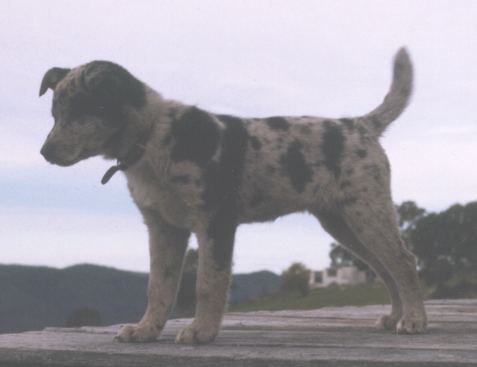
Jade at 9 weeks old
I liked the name. It suited the kind of dog I hoped she would become.
The first week
Training began early for both of us. During
my first week with Jade, I returned her to her
mother during the day. I was woolclassing for
Coral and Max during their week-long shearing –
over 1000 Merino sheep. So, at 7:15am, I dropped
her off at her mother’s kennel, and at 5:30pm, I
picked her up again. Every morning at 7:15am,
Jade immediately latched onto her mother’s teat.
Silver didn’t make any attempts to wean her
during that week.
I had decided Jade would be an outside dog, so I put her in a cage outside at night with a blanket and basket. I listened to her screech and wail for 2 nights before I relented. Her new sleeping location was a cardboard box next to my bed. (She has been an indoor dog since then. As she outgrew her cardboard box, she graduated to a floor mat at my bedside.)
I also learned that she was extremely intolerant to being in a moving vehicle. Every morning and evening, as I drove along the dirt track, she was carsick before I reached to the first gate.
First meeting with calving cows
My cows were due to calve, so on one of my
visits to the cow's paddock, I took Jade. As
I strode through the tall grass, I noticed my
pup wasn’t keeping pace with me. She was
struggling to leap over the thick tussocks.
I picked her up and carried her. In the distance,
I could see the cows and a new calf. I wanted to
get a closer look. I carefully climbed through the
fence holding Jade. I walked up the hill and
through the trees.
As I got closer, the cows raised their heads to watch me. I regularly hand feed them, so I didn’t expect them to feel unduly threatened by my presence. But, then, this little pup growled a loud and ferocious growl. One of the cows began to quickly charge toward me. I was startled, not only by my little pup’s audacity to growl at something so big, but by the thundering gallop of a cow aiming herself at me! At the right moment, I sidestepped behind a tree. I asked my dog to be quiet, although she would not have known what that request meant, yet.
Then, I remembered I should talk to my cows. They know my voice. That made the difference! They remembered the many times that I spoke gently to them (or sang off-key) and gave them hay. As the cows drifted away, I emerged from behind the tree (still holding my pup) and retreated down the hill.
From that moment to today, my cows and Jade have maintained a special, antagonistic relationship. Jade is agile enough to get out of their way, but still audacious enough to bark at them. Sometimes, Jade is able to successfully move the cows and calves in the right direction for me…
Observing and training
I bought and read as many books as I could on
caring for and training a working dog. Not
only did I have to train her, I, too, had to
learn how to be a good trainer. I needed to
be consistent and aware. She was going to
learn something every time I responded or
interacted with her. What had I taught her
on each occasion? Was it a desirable behavior
or a mistake?
My neighbor’s grandson told me about his young dog. “He just keeps barking! So, I get a piece of meat and give it to him. That’s the only way to make him quiet!” I listened, thinking about the advice I had read in many training books.
“You are rewarding him for barking by giving him meat. You are also rewarding him by responding to his barking in any way.” I told the young fellow. “Maybe, you should give him a piece of meat when he is doing all the right things – when your dog is quiet.” He looked thoughtful, but didn’t say a word.
I was becoming more and more aware of how my behavior affected my pup, too. When relaxing inside my house, I wanted to hold my puppy, but I had also decided that I did not want a dog that ‘owned my furniture’. The compromise for both me and my puppy was that I held Jade while I sat on the floor. [Today, she never jumps onto furniture, and if called to ‘jump up’ she doesn’t stay on the chair or couch – she doesn’t seem comfortable there.]
“No bite” training
In the early days I had tiny puncture marks
and scratches from my dog’s puppy teeth.
I had to do substitute play – to compensate
for her not being able to engage in play with
other puppies. My play included yelps when I
was hurt and withdrawing and ignoring her.
Sometimes it included biting her gently on
her ear when she insisted on biting me.
Sometimes during play, I had to resort to
rolling her onto her back and growling out
a fierce “NO BITE”. I tried to keep that
option as an infrequent last resort – I
had read that rollover and standover tactics
could be overused to the detriment of the pup.
Riding in the back of the truck
I took her with me everywhere possible. One
of my early trips with Jade was only about
45 minutes to a clearing sale (a used farm
equipment auction). I wanted her to be
accustomed to riding in the back of my truck,
so she rode in the enclosed canopy area.
After arriving at the clearing sale, it was obvious that Jade had been distressed at riding in the back. She had vomited and defecated. After cleaning her up, I decided to carry her.
There were a few older dogs wandering about, and I didn’t want her to be traumatized by aggressive, larger dogs. As I looked at the items for sale (all placed on the ground in long neat rows), holding Jade became more difficult. She was squirming to greet some of the other dogs. I relented. On lead, I let her “greet” both dogs and people. None of the dogs were aggressive, just inquisitive.
To return to the farm, I wanted to put Jade in the back of my truck again, but she was frightened; I let her ride in the front with me. (And perhaps, you can guess, that has become her usual travelling location.)
Weeks later, I tried putting her in the back and she shook with fear. So I asked Michael to drive, and I sat in the back and held her. She trembled and leaned tightly against me. We periodically continued this gentle conditioning, and she has vastly improved.
In hindsight, putting her all alone on that first truck trip was damaging to her confidence. I am continuing to undo the damage. She will jump into the back and ride next to one of us or a-friendly-dog. However, she is most reluctant to travel in the back by herself.
Front seat vocabulary training
Riding in front with me has enabled me to
continue her training. I point out: sheep;
ewes; rams; lambs; merinos; crossbreds;
cattle; cows; steers; Angus cattle;
Hereford cattle; Black-Baldy calves;
Murray Grey cattle; Santa Gertrudis c
attle; kangaroo; wallaby; wombat; rabbit;
birds: Sulfur-Crested Cockatoo, Magpie,
Rosella; truck; bus-truck’ car; little
truck; dog; and more. She is more
interested in some than others. Trucks,
bus-trucks, and kangaroos are all far
more interesting to her than birds.
I can do it
As a puppy she had a strong independence
and pride. Because the truck seat seemed
too high for such a small puppy to jump
onto, I picked her up for each trip. One
day, Michael drove through our gate; I
closed the gate; then walked over to
Jade. I reached down to pick her up,
and she danced away from me barking.
I was puzzled, but decided to ignore
her. I got into the truck, closed the
truck door and asked Michael to drive
a short distance, appearing to leave
her behind. She moved forward with us.
Again, I opened the door and got out
of the truck, to pick her up. Once more,
she barked at me. “OK”, I said, “What is
it?” As I straightened up, she jumped
into the truck by herself! She was so
pleased. She had been trying to say,
“I can do this myself!” Michael and
I gave her lots of praise, too. From
that point, this tiny puppy jumped
into the front of the truck without
help.
Socializing with a Dingo
She outgrew her carsickness. When
Jade was nearly four months old,
my husband Michael and I drove North
to Queensland to visit Michael’s
dying Mother. From Canberra (Australian
Capital Territory) it took us 2 full
days of driving with an overnight stop.
Jade travelled with us. In Queensland,
she met and played with a large friendly
dog named ‘Benny’ (a Dingo cross Blue
Heeler) and a fiesty, fluffy miniature
Silky Terrier named ‘Harry’. She
watched them swim into the Tallebudgera
Creek chasing sticks. She waded into
the Creek, but was reluctant to venture
far. She also watched Benny at play,
and learned to catch a tennis ball.
Salt Water Swimming
Later that year, friends invited us to
Bermagui on the southeastern coast of
New South Wales for a visit. Jade
watched ‘DG’ the Rottweiler swim in
the Pacific Ocean surf. My friend
Susanne found a small rock pool and
gently introduced and encouraged Jade
to the idea of paddling in the clear,
salty water. Later on that same visit,
we waded in a sheltered, clear, salty
inlet. Jade wanted to be with us. She
watched DG fearlessly swim around us.
Jade barked at us; she was alone on the
beach; she wanted to be with us; she
began swimming! Jade learned to swim,
and she loved it.
Obedience Classes and Training
I enrolled us into a puppy obedience
class. We were both about to learn.
When Jade was 11 weeks old, I attended
the first puppy obedience class without
her. I made sure Jade had all the
required vaccinations, and by her
12th week we began attending together.
It was a good, important socializing
time for my dog. We progressed through
the various obedience classes and
levels, accumulating a 2nd place and
a 3rd place ribbon in some of the
competitions. For nearly 18 months we
went to obedience classes once a week.
We eventually began Agility classes, too.
It was at that time that my Father became very ill. I flew back to the USA to be with him. He died at home. I was away for two months.
Because my husband was travelling extensively, I left Jade with a friend who was very good at understanding, training and handling dogs. Two months later, when I returned to Australia, I reclaimed my dog. I had wondered if Richard would be able to give her up after such a long ‘bonding’ time. I also wondered if Jade would remember me.
I didn’t resume obedience or agility classes after that long absence. I began concentrating more on sheep work. I had been exposing Jade to sheep regularly. Her first early exposure was at lambing. Michael held a lamb in his arms, and I held Jade. We brought them close to each other. Jade tried to bite the lambs ear. I immediately yelled out a “No Bite”. Jade knew what I meant.
Jade was gradually becoming stronger and fast enough to chase and encircle a small mob of sheep. As she develops, her sheepwork is increasing.
She already saves us an enormous amount of frustration and running when we bring our sheep into the yards. Once the sheep are in our stockyards: she jumps up on the backs of the sheep to help fill the work race.
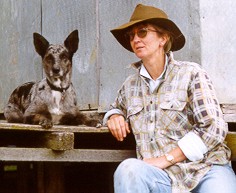 |
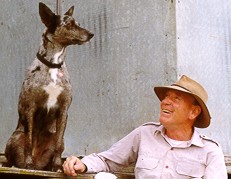 |
At the Shearing Shed |
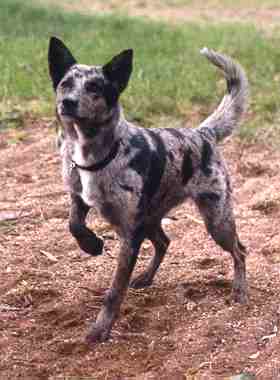 |
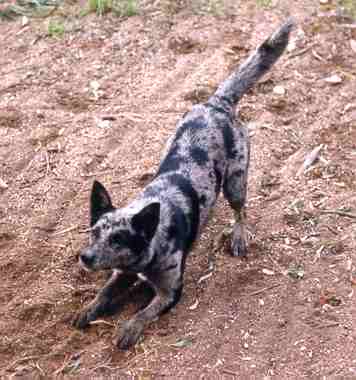 |
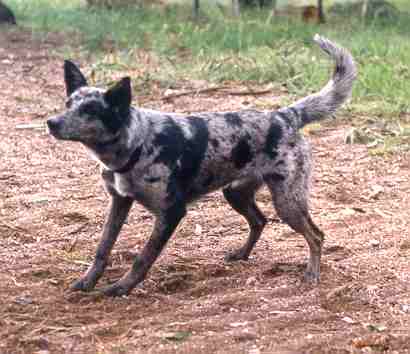 |
Watching sheepdogs perform
Michael and I attend local agriculture shows
not only to support our local community, but
also to learn. When Jade was less than a
year old, we took her to the Nimmitabel
Agriculture Show. We spent most of our time
watching the sheepdog trials from an elevated
seating area. As each competitor and dog
finished their rounds with the sheep, the
audience politely clapped. Jade barked out
her congratulations. The audience was amused
at our “approving dog”.
| When Jade was 2.5 years old, we again took her to the Nimmitabel Show (and then the Dalgety Yard Dog Trials, too). We spent all day watching dogs and sheep. Jade watched keenly. She didn’t take her eyes from the sheep, handler, and dog. It was obvious that she wanted to “help” the competitors. She fidgeted, sat, stood, quivered with excitement, and quietly whimpered. I hope she learned something good! | 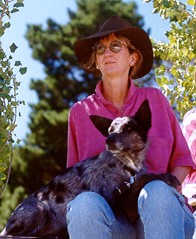 |
| Focused on the sheepdog trials |
Abandoned lambs
Before Jade, I would annually “collect”
abandoned merino lambs to raise. One year,
I attempted to raise four. Most recently,
one of our ewes died, leaving an abruptly
weaned small merino ewe lamb. We found the
adult ewe carcase. Then later, when we did
a final check after a full muster of ewes
and lambs from our “Scotch” Paddock, we
found the orphaned ewe-lamb wandering
alone in the empty paddock among the
tall grasses.
We picked up the orphan. I immediately looked for any defects – eyes ok, teeth and bite ok. I was driving, but I continued to hold it in my lap. Oops – we were bonding.
We took it back to the cottage, and I gave it a diluted, warmed milk mixture.
With some introductory learning difficulties, it eventually understood what was happening and then sucked the mixture. During this event, Jade was very interested, and wanted to help. Jade sniffed and licked the lamb. I put the lamb in a small cage outside the farm cottage. That’s where Jade wanted to be all of the time.
I had hoped the lamb would gain weight quickly, so I could return it to the mob of ewes and lambs. It wasn’t gaining quickly. So, I took it with me to suburbia. I put the orphaned lamb in the fenced backyard in suburbia. I gave it milk, hay, and anything else it found to eat. One of the first things it ate was a small apple tree seedling: all of the leaves were gone and some of the tender stems, too. Initially, the lamb had all of the backyard, and Jade had the house. I kept them separate for awhile, taking Jade on long compensatory walks. Then I began letting Jade and the lamb share the backyard.
Training in earnest began. I corrected Jade each time she tried to roughly push the lamb around or chase it. I worked with Jade to let her know that this was not a sheep to be chased.
| Jade has learned to discriminate between this “pet” lamb and the sheep in the paddock. Our “Little Orphan Annie Lamb” and Jade cohabit the backyard with no problems. Annie Lamb treats Jade as a boisterous, protective, dominant sheep, often following Jade around the backyard. Jade responds to Annie as a strange, timid dog with odd eating habits. | 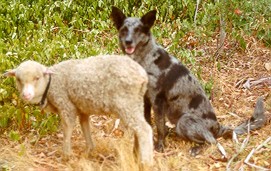 |
| “Little Orphan Annie” Lamb and Jade |
|
Tough, rare Jade
As time goes by, Jade is certainly becoming tougher and gentler and more rare than I had imagined. Owning a Koolie has enriched my life. As far as preserving life, well, we’ll see as time goes by … |
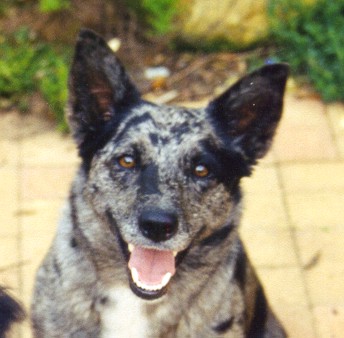 |


The author Doris Ann Kalivoda was born
in the USA and moved to Australia fourteen
years ago. With a Masters degree in Computer
Science from Johns Hopkins, she worked in the
computing field, but wanted to experience the
“real” Australia. She studied sheep, cattle,
goats, and rural property management in her
spare time - to become a farmer/grazier. She
has obtained qualification for, and is a
practicing Australian Professional WoolClasser.
She has also obtained recognition as an ACMC
(Australian Cashmere Marketing Corporation)
Pool Classer. Her farm is 850 acres and within
sight of the snow covered Snowy Mountains with
3 kilometers of Maclaughlin River frontage.
She enjoys raising sheep and cattle and the
many disciplines required to succeed in
farming. She hopes that one day the farm
will financially support her...

What’s a Koolie?
Jade is a short-haired, black and gray
Koolie. The breed originated in Australia
around 1800 as a result of German and other
European immigrant farmers importing their
working dogs as they settled in Australia.
Although parentage and breeding records were
not kept, it is believed that the Koolie
breed is one of the oldest breeds of working
dogs in Australia.
Even though there are no written breed records, the Koolie (also known as Coolie, Coulie, Coullie, German Koolie) is thought to have descended from the highland blue merle sheep dog and the Smithfield breed. The Koolie was bred to work both cattle and sheep in both yards and paddocks.
More than a working dog, the Koolie has the capacity to be a loyal, highly intelligent companion dog. It is both non-aggressively protective and fun-loving.
When I take Jade for walks in Canberra (Australian Capital Territory) suburbs, she ignores passers-by if I do. But, if I smile and greet anyone, Jade wants to add them to her fan club, too. She is most successful at making new friends.
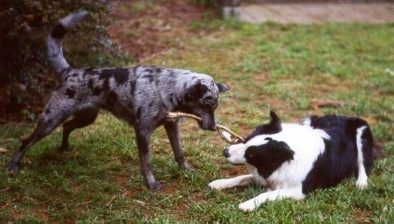 |


Copyright © 2001 Delmont Pastoralists. All rights reserved.